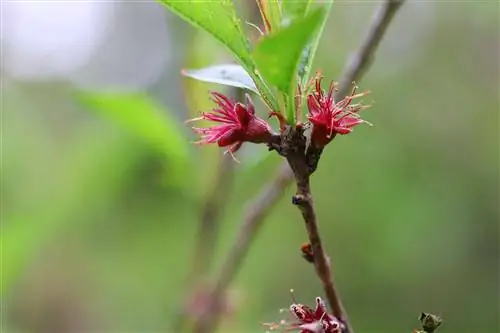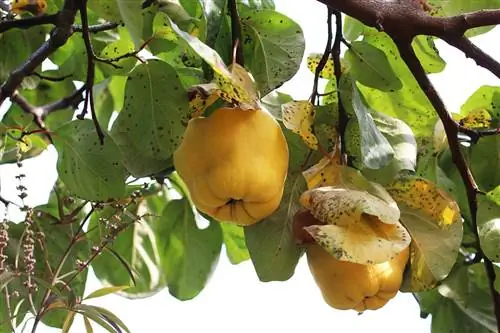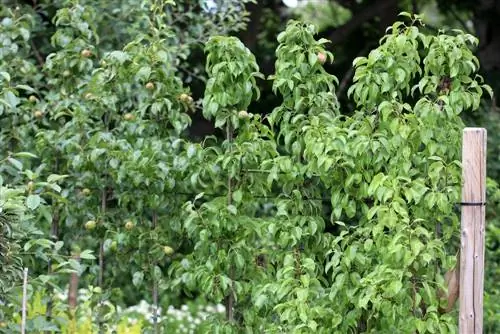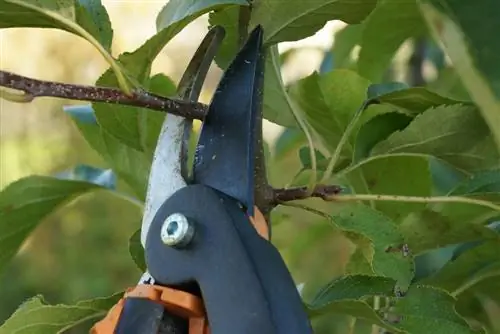- Author admin [email protected].
- Public 2023-12-17 03:39.
- Last modified 2025-06-01 06:48.
Sweet, crunchy and he althy - delicious fruit is one of the most popular types of plants grown in our local green spaces. The classics include easy-care fruit trees that should not be missing in any garden. But when planting trees, special attention must be paid to the optimal tree neighbors; If you choose the right types, you can increase your yields and significantly improve the fruit quality of the fruit. In addition to similar site conditions, pollination and fertility of the tree also play a role in choosing the right partner.
Preliminary considerations
Basically, different criteria can be used to decide which fruit trees are suitable as ideal neighbors. The experienced hobby gardener takes the following aspects into account:
- Is a mixed culture desired to strengthen plants?
- Does pollinator varieties force species-like neighborhood planting?
- Is this a robust variety?
- What location conditions exist for the different varieties?
- How much space is available?
The size of the garden must also be taken into account in all considerations; If you only have a small area available for planting, you will often resort to mixed culture in order to accommodate as many different species as possible. However, this only applies to self-fertile fruit trees; if it is a species that requires an additional pollinator, two identical species must be planted next to each other. Then it's better to concentrate on one or two favorite species.
Tip:
Today there are numerous new varieties available in mini format that can also be planted next to unfavorable plant neighbors. However, these usually deliver lower yields depending on their size.
Creating mixed culture - advantages
Creating a mixed crop means that different types of fruit trees are planted in close proximity to each other. More and more hobby gardeners are choosing this method and, for example, planting apple trees next to cherry trees. This planting offers the following advantages:
- Effective pest control
- Improving plant growth
- Intensifying the fruit flavor
Several varieties planted next to each other can ward off annoying pests in the long term. Not only does the mixed culture of different fruit trees achieve this effect, but also the combination with various herbs. This type of planting also increases soil fertility, which has a positive effect on plant growth. Different fruit trees attract different types of insects that act as pollinators; Yields can be increased and fruit quality improved.
Location-dependent fruit tree partnerships
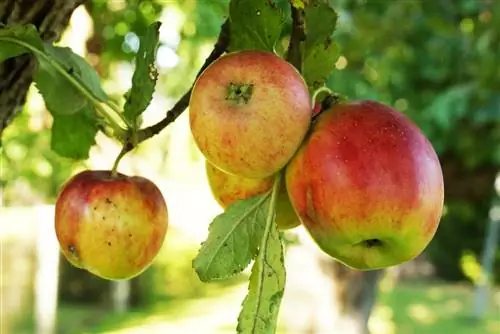
So that different types of fruit trees benefit from each other, it has proven to be a good idea to take the respective location requirements into account, especially with regard to the following conditions:
- Soil moisture
- Substrate nutrient reservoir
- Location of the location (shady or sunny)
The soil plays an important role when planting fruit trees. For example, apple trees tend to thrive in moist soil, while pears prefer warm and dry substrate. If the soil is uniform, plums go particularly well with apples, as they also prefer a slightly moist substrate. Both species also thrive particularly well on nutrient-rich, humus substrate. Pear trees, on the other hand, feel at home next to cherries.
In addition, the location of the site plays an important role when combining fruit trees. In the immediate vicinity, all of the same species are available, for example different types of apple trees. In mixed culture, all sun-loving species can be combined in the same location; Neighborhoods are possible, for example, between the following types:
- Apples and Plums
- Apples and sweet cherries
- Plums and sweet cherries
If there is only a heavily shaded area available within the local green area, figs and sour cherries feel comfortable next to each other; Certain apple varieties can also be planted in the immediate vicinity. However, the fruits then remain correspondingly smaller. Not only fruit trees, but also fruit bushes can be combined with the different types; For example, currant bushes that are planted next to fruit trees deter many pests (e.g. voles and other rodents).
Herbs that are planted underneath also represent an ideal mixed culture with all types of fruit trees, for example nasturtium, horseradish or garlic. Nasturtium also offers the advantage that it acts as a living mulch for rotting plant parts. In this way, additional fertilizer can be saved.
Pollination of fruit trees
- Reason for optimal planting neighborhoods -
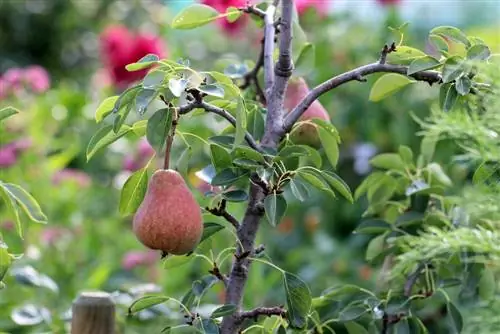
Many hobby gardeners are happy when their fruit trees are in full bloom in spring - and are then disappointed when the harvest turns out to be small. The cause of such yield problems is often poor pollination - which can have the following causes:
- wrong plant partners
- too few insects
- Weather problems
In most cases, the yield can be increased if you find suitable plant partners. Although a fruit tree can generally stand alone in the garden, having two trees relatively close to each other increases the likelihood of a high yield enormously. Depending on the type of tree, the fruit trees support each other in fertilization in different ways; With kiwis, for example, it has proven useful to plant two trees of the same species right next to each other. These types of fruit, known as dioecious, fertilize each other because one has male flowers and the other has female flowers.
Garden owners who want a rich kiwi harvest should plant primarily female flowers, but at least one male flower in the immediate vicinity of the garden. However, many of our most popular fruit trees are hermaphrodites; these bear both female and male organs in a single flower. These include, for example:
- Plums
- Apples
- Cherries
- Pears
However, this does not mean that these species, when planted individually, produce high yields; Nevertheless, it has proven useful in many cases to plant two identical varieties in direct proximity to one another. For example, the flowers of many apple varieties require the pollen of another apple variety so that a fruit can ripen. In addition to apples, pears and most varieties of sweet cherries are also sterile, so at least two trees should always be planted next to each other.
If there is not enough space in your local green area to provide enough pollen for the flowers, it may be advisable to switch to species that are represented in the neighboring garden, for example. In this way you can ideally supplement your own pollen supply.
Pollen supply, location requirements and optimal location of the fruit trees: Those who concentrate on the different needs of their fruit trees specifically select the right plant partners. In this way, yields can be optimally increased - in every garden.


